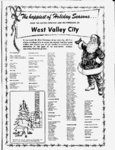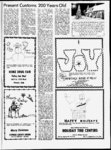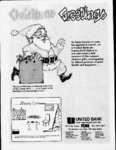| OCR Text |
Show It's Many Things - Customs Change Yuletide Ritual Jingle , Bells Dashing mro me snow, in e a open sleigh; Oer the field we go, laughing all the way; Bells on bobtail ring, making spirits bright; What fun it is to ride and sing a sleighing song tonight! one-hors- A day or two ago I thought Id take a ride; And soon Miss Fannie Bright was seated by my side. The horse was lean and lank, misfortune seemd his lot; He got into a drifted bank, and we, we got upsot. Now the ground is white; go it while youre young; Take the girls tonight, and sing this sleighing song. remembers. Usually it is thought of as Jingle Bells, but early copies of the song show that the title was really meant to be Jingle, Bells with a comma added to make it a command to the bells to go into action. Both the melody and lyrics were written by James Pierpont, who was the son of a minister and who ran away to sea at the age of 14. Pierpont wrote the song in the late 1850s, according to Enclopedia Americana. He was then living in the Boston suburb of Medford where, at the time, the only piano in the entire village was located in the parlor of Simpsons Tavern. It was there Pierpont picked out the Jingle, Bells melody. - Christmas, 1980 does not come to a world that is perfect. Many nations are at odds. There are wars and rumors of war. And cold wars. There is poverty, even in the richest land on this earth. But, this is the day we have set aside to recognize that momentous event that took place in Bethlehem centuries ago. This is the hour when men pause, when combatants often call for a momentary pause . . . when, in essence, many of the affairs of the world are set aside for a few precious hours. Christmas, indeed, is such an universal holiday, that it somehow touches the lives of everyone, even unbelievers. Christmas day is not a perfect day. Do not expect it to be. But give it a chance to touch you. Take a closer look at your world on this Christmas Day. Take a look into your own heart. You may find some singular experience that will lead toward a better tomorrow. When was the first carol sung? Scholars think caroling probably began in the early church when Nativity plays, accompanied by songs of joy, told the story of Christs birth. One of the earliest choruses of praise, Gloria in Excelsis Deo (glory to God in the highest) is still sung by carolers at Christmas time. Early g worshippers must have shouted it forth with a Magna Vox (also Latin, for great Latin-speakin- voice). many people dont realize it, carols were Though originally connected not only with song but with dance; The Old French meant a word carole ring dance accompanied by song. An English carol dating from 1350 has a refrain which refers to a round dance: Honnd by honnd schulle ous take and and joye Santa Claus is a wanted man. He wont be easy to track down either, for he has too many aliases! In one part of the world he pops up under the name of Julenissen; in another, the Abbot of Unreason; and in a third, as Saint Nicholas. we blisse schulle we make. Early carol composers didnt confine themselves to Christmas themes - a Santas arrival date collection of Carolles ly Imprinted New(1550) con- tained more Crucifixion than Nativity carols! On the other hand, quite a few carols of this time were not sacred in mood, but simply lighthearted invitations to feasting and toasting. The Boars Head carol, a big hit in the 16th century England and still sung annually by the students of Queens College, Oxford, actually celebrates the course of words; boars head in hand bear I Bedeckd with bays and rosemary. The And I pray you masters, be merry . . . The custom of outdoor carol singing is many hundreds of years old. It seems to have started in the Middle Ages when groups of people went from house to house to sing by torchlight. Yet despite these joyous beginnings, the Christmas carol eventually ran into some rough weather. As the Puritan influence grew strong, the result of American influence on British customs. In England, too, the kinds of gifts that Santa brings are becoming like American gifts. A generation ago, Englishmen tended to be more practical. Husbands gave their wives a new cooking pot or a pair of new overshoes. Happily for Englsh womanhood, Englishmen are learning fast that English women like fun, luxury gifts as well as any woman. Here is a rogues galof Santas aliases lery around the world: The Abbot of Unreason. In the Middle Ages, the became an officer who directed the festivities of the holiday season. Dubbed the Abbot of Unreason by the Scots, and the Lord of Misrule, he held office from Christmas till January 6, and his word was law. Either elected or appointed, he ruled over holiday activities in royal households, cottages, and inn. The English called him King of the Bean, and to the French he was the Boy Bishop. Saint Nicholas. In the 4th century he was modeled after the original St. Nicholas, who lived in Turkey and whose deeds of kindness earned him the title of patron saint of children. The legend of the good was saint as a later spread to Russia, Scandinavia, Holland, Belgium and Germany. sing them publicly! After Puritanism waned in England carols made a comeback. carols became gloomy and grim; finally the Puritans made it a crime even to print them or de- pends strongly on local customs. In Holland, the custom of leaving secret gifts for children on St. Nicholass birthday became popular centuries ago. Even today, presents are exchanged on this day, Dec. 6, rather than on December 25. A bale of hay is often laid out for the benefit of Santas horse, not his reindeer. In Spain and Italy, Santa arrives a whole month later, on Jan. 6, Epiphany. This day seems very appropriate, for it is the day on which the Three Wise Men delivered the very first Christmas present, in Bethlehem. In Italy, incidentally, Santa is a she. In France and Scotland, Santa arrives Jan. 1, New Years Day. In England, where gifts were once distributed exclusively on the day after Christmas, Santa is seen more and more often on Christmas Eve, as he is here. This change is gift-giv- er gift-giv- er (9 (9 0 L g f9 i9 C- 19 (9 (9 -. v.- g r- 19 g V " J i 5 Drawn by Yvette Irene McArthur, 4th grade, John C. Fremont School. Parents: Mr. & Mrs. Gary McArthur. Soot oils Greetings from the Staff end Management of HENRY S. DAY FORD 3S9 9 So. Redwood Rd. 973-703- 0 h ) 19 Drawn by James McEwan, 1st grade. Western Hills Elementary. Parents: Mr. & Mrs. John McEwan. Merry Christmas From cu "The Family Health and Home Center" 4067 5415 So. W. Kearns Shopping Oiitoi 968-354- 4 y&uyCL |










































